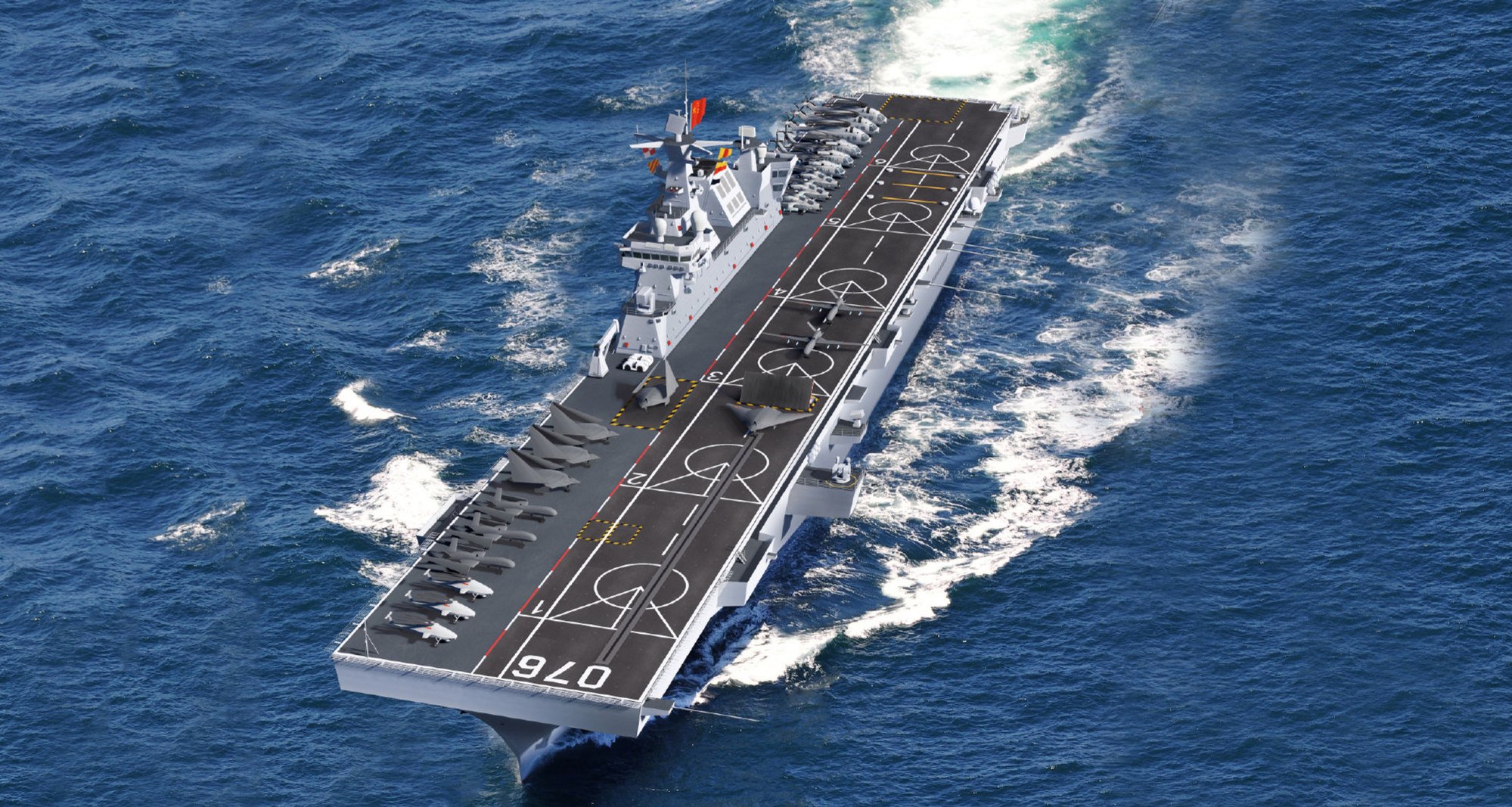Report on ‘mystery ship’ comes as China also builds giant 076 amphibious assault warship that will serve as both a helicopter and drone carrier. Specs indicate ‘an aircraft carrier of some sort’, while low flight deck would ‘make sense’ in a drone carrier, Naval News says. — SCMP
China may have built the world’s first “dedicated” drone carrier, military website Naval News reported, citing satellite imagery and an expert.
The new aircraft carrier, the building of which has not been publicised by Beijing, could underline China’s aims to advance the military use of drones and their deployment in battle.
Video from the first sea trial earlier this month of the Chinese navy’s third and most advanced aircraft carrier, the Fujian, also showed another giant warship under construction – the Type 076 amphibious assault ship believed to serve as both a helicopter and drone carrier.
Naval News reported on Wednesday that satellite imagery from the Jiangsu Dayang shipyard on the Yangtze, far upriver from the major yards of Shanghai, suggested that China had secretly built a new aircraft carrier to specifically host fixed-wing unmanned aerial vehicles (UAVs).
It said the features of the mystery ship, “launched in December 2022 but not reported until now”, were different from regular US or Chinese aircraft carriers.
This includes a smaller size – around one-third the length and half the width of a US or Chinese supercarrier – and an “anachronistic” straight deck arrangement that would not allow aircraft to take off and land at the same time.
It would be possible to operate fixed-wing aircraft from the vessel, which is wide enough to host aircraft or drones with a wingspan of around 20 metres (about 66 feet), the report said.
However, the vessel’s low flight deck suggested insufficient space for an aircraft hangar below to support high tempo or prolonged flight operations, it said. This would limit the number of aircraft supported by the ship but “make sense” as a drone carrier.
“It is immediately apparent that it is, in general arrangement, an aircraft carrier of some sort. It has a marked runaway running along the port [on the left side] with an island superstructure on the starboard [right] side,” the Naval News report said.
“Beyond this, it is unusual in every respect. The hull is a widely spaced catamaran. While catamarans are often featured in aircraft carrier concepts because they allow a large deck area, no one has actually built one before.”
Navies around the world have been running trials to operate UAVs from regular aircraft carriers as drones become a key part of warfare, with frequent usage in the ongoing wars in Ukraine and the Middle East, Some countries, such as Iran and Turkey, are also said to be working on plans to build carriers specifically designated to host drones.

China leads the world’s military drone market, exporting more than 280 combat UAVs in the past decade, especially to the Middle East and South Asia, according to the Stockholm International Peace Research Institute (SIPRI) arms transfer database.
The Fujian is the Chinese navy’s latest aircraft carrier after the Liaoning and Shandong.
Launched in 2022, the supercarrier is China’s first to be equipped with electromagnetic catapults. Eight days of sea trials earlier this month, including tests for power and electrical systems, achieved “the expected results”, according to Chinese state media.
Unlike the ski jump-style ramps of the two older carriers, the Fujian’s electromagnetic catapult system allows aircraft to launch more frequently and also carry more fuel and munitions.
As the Fujian left Shanghai’s Jiangnan shipyard for its first sea trial, the Type 076 drone and helicopter carrier was also in the frame, seen for the first time since its construction was publicised in mid-2020. The amphibious assault ship is expected to be the fourth largest warship of the Chinese Navy after the three aircraft carriers.
The Type 076 will feature electromagnetic catapults, an integrated electric propulsion system and host fixed-wing aircraft. Photos circulating online last September showed it to be under construction at Shanghai’s Hudong-Zhonghua shipyard, close to Jiangnan.
The reasons behind China’s addition of the world’s first drone carrier to its naval fleet, “remains something of a mystery”, Naval News said. One possibility is that the ship will be part of an opposing force for training, or “Electronic Blue Force”, as several hi-tech target barges and two large drone mother ships had already been built at the same shipyard.
“The shipyard where it is being built, Jiangsu Dayang Marine, has previously built simulated enemy ships for the (Chinese navy),” said J. Michael Dahm, a senior resident fellow at the Mitchell Institute. Dahm analysed the carrier in collaboration with Naval News.
“China has an extensive programme of simulating Western and Western-leaning navies’ ships in its weapon testing programme, and its anti-ship ballistic missiles are tested on full-size outlines of US Navy aircraft carriers.”
But as the first drone carrier, it could not be mimicking any known Western ship, according to the report, which said “a second possibility is that it is some type of experimental platform that will test and develop drone operations at sea”. – South China Morning Post





